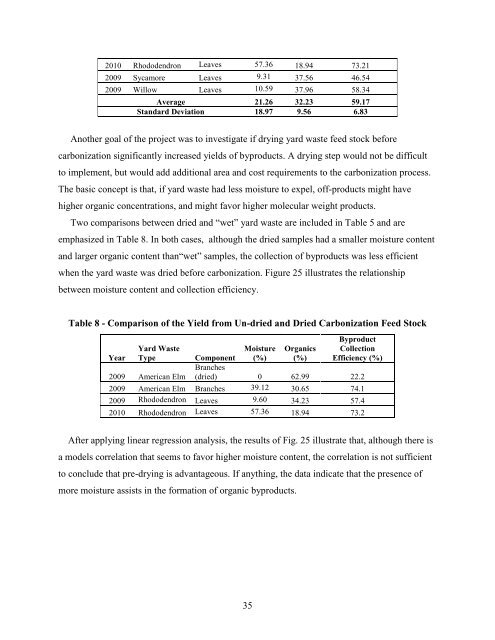Final Report - Ohio Department of Transportation
Final Report - Ohio Department of Transportation
Final Report - Ohio Department of Transportation
You also want an ePaper? Increase the reach of your titles
YUMPU automatically turns print PDFs into web optimized ePapers that Google loves.
2010 Rhododendron Leaves 57.36 18.94 73.21<br />
2009 Sycamore Leaves 9.31 37.56 46.54<br />
2009 Willow Leaves 10.59 37.96 58.34<br />
Average 21.26 32.23 59.17<br />
Standard Deviation 18.97 9.56 6.83<br />
Another goal <strong>of</strong> the project was to investigate if drying yard waste feed stock before<br />
carbonization significantly increased yields <strong>of</strong> byproducts. A drying step would not be difficult<br />
to implement, but would add additional area and cost requirements to the carbonization process.<br />
The basic concept is that, if yard waste had less moisture to expel, <strong>of</strong>f-products might have<br />
higher organic concentrations, and might favor higher molecular weight products.<br />
Two comparisons between dried and “wet” yard waste are included in Table 5 and are<br />
emphasized in Table 8. In both cases, although the dried samples had a smaller moisture content<br />
and larger organic content than“wet” samples, the collection <strong>of</strong> byproducts was less efficient<br />
when the yard waste was dried before carbonization. Figure 25 illustrates the relationship<br />
between moisture content and collection efficiency.<br />
Table 8 - Comparison <strong>of</strong> the Yield from Un-dried and Dried Carbonization Feed Stock<br />
Yard Waste<br />
Moisture Organics<br />
Byproduct<br />
Collection<br />
Year Type Component<br />
Branches<br />
(%) (%) Efficiency (%)<br />
2009 American Elm (dried) 0 62.99 22.2<br />
2009 American Elm Branches 39.12 30.65 74.1<br />
2009 Rhododendron Leaves 9.60 34.23 57.4<br />
2010 Rhododendron Leaves 57.36 18.94 73.2<br />
After applying linear regression analysis, the results <strong>of</strong> Fig. 25 illustrate that, although there is<br />
a models correlation that seems to favor higher moisture content, the correlation is not sufficient<br />
to conclude that pre-drying is advantageous. If anything, the data indicate that the presence <strong>of</strong><br />
more moisture assists in the formation <strong>of</strong> organic byproducts.<br />
35
















